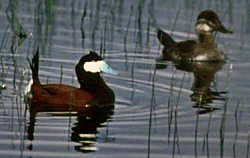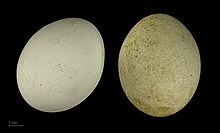Ruddy duck
| Ruddy duck | ||||||||||
|---|---|---|---|---|---|---|---|---|---|---|

Ruddy Duck ( Oxyura jamaicensis ) |
||||||||||
| Systematics | ||||||||||
|
||||||||||
| Scientific name | ||||||||||
| Oxyura jamaicensis | ||||||||||
| ( Gmelin , 1789) |
The ruddy duck ( Oxyura jamaicensis ) is a kind from the family of ducks . She is considered one of the most typical representatives of the rowing ducks .
Originally native to North America ruddy ducks are in Europe to the captive refugees who have established themselves so firmly in Europe to as invasive species apply. Since they mix strongly with the European white - headed rudder ducks and threaten to displace them in the long term, extensive measures have been introduced to contain this species within Europe.
Appearance
anatomy
Like all rowing ducks, the black-headed rudder is characterized by a head that is noticeably thick in relation to its body with a broad, somewhat distended beak. The body is stocky, the tail long and stiff-feathered. It is often used by both sexes outside the courtship season. Despite the small, curved wings, black-headed rudders are considered to be skillful and fast fliers. The females weigh an average of about 500 grams; the males are 100 grams heavier.
In comparison to other ducks that do not belong to the rowing ducks, the legs are set very far back on the body. You are thus well behind the body's center of gravity. The black-headed Ruddy Duck is able to swim and dive very powerfully. On land it seems rather clumsy. In order to get the necessary flight speed, the rudder duck has to run up for a long time on the water surface and flap its wings very hard.
plumage
In the splendor and breeding dress, the male has a black head with white cheeks. The beak is strikingly light blue. The body plumage is bright maroon. In the resting plumage the body plumage varies between gray and brown, the beak is then dark gray. The headstock is rather black and gray during this time. The white cheek areas and the white color of the under tail cover remain in place during this time.
The plumage of the female is tinted gray-brown all year round, with the color intensity varying between the individual body parts. The beak is also dark gray all year round and does not appear as strongly distended as in the male.
Ruddy ducks moult their plumage after the breeding season. In males, this full moult begins at the end of July or at the beginning of August. The females do not moult until the end of August. The prenuptial moult falls between February and April. The mainsprings are only completely renewed for the second time in around ten percent of the individuals.
voice
The Ruddy Duck is a largely silent bird. She only lets out a vocal “ quärr ” during courtship . Her sound repertoire also includes a number of instrumental sounds . The males make rattling noises with their open beak during courtship. These noises can also be heard occasionally by the female. They also tap their beak on the inflated throat pouch, producing a sequence of burping and clicking noises. In terms of onomatopoeia , they can be described as tik tik tik tikiktktktktk trrrr or dü düdüdüdü-grüuik . The flapping of their wings on the surface of the water is also clearly audible.
Way of life
Ruddy ducks are breeding birds that are found throughout most of North America. They nest in the reed thicket near the water and only enter into seasonal marriages. In winter they move to the bays of the coastal waters and to the lakes and ponds that are not yet frozen over. They live mainly on the seeds and roots of various aquatic plants, aquatic organisms and small mollusks . With their broadly drawn out beak, they strain the mud floor of water about one meter deep. This duck usually dives in relatively shallow waters. It looks for its food in parts of the water, the bottom of which is a little beyond the reach of ducks that are digging.
Reproduction
The females of the Ruddy Duck breed for the first time in the first year of life. The males are usually older than two years. The nest is built in dense vegetation near shallow waters. Very often the nest, which is woven with vertical stalks, has a dome-shaped roof made of bent plants. Ruddy ducks begin to lay their eggs in mid-April. The clutches usually contain between six and ten eggs. The eggs are wide-oval and have a matt whitish to cream-colored color. The female incubates the clutch between 23 and 26 days, with incubation beginning with the last egg. Young birds leave the nest as early as 20 hours of age; they are led by the female. Occasionally the male is also involved in guiding the young birds.
The young chicks can dive very early. At about four weeks they are abandoned by the female and are then independent. With 50 to 55 days of life they are fully fledged. In Europe there is usually only one annual brood, this is also the rule in North America and only regionally black-headed ducks raise two clutches per year.
Duration
The IUCN estimates the total population of the Ruddy Duck at 510,000 animals. The species is considered "not endangered".
Ruddy ducks as neozoa in Europe
In 1948 seven black-headed rudders (four males and three females) were imported from the USA to Great Britain . Between 1953 and 1973, a total of around 90 descendants of these animals were released as so-called captive refugees; The first brood was found there in 1960. By the year 2000, the wild population in Britain had increased to around 5,000 animals. The mainland was colonized from Great Britain. The first observations of apparently wild rudder ducks in Germany date back to 1980. Since then, rudder ducks have been observed very regularly in Lower Saxony , North Rhine-Westphalia and Schleswig-Holstein during the summer and breeding season. In the south of Germany as well as Austria and Switzerland, however, black-headed rudders are mainly observed in autumn and winter. In total, observations of the species were reported from 21 countries in the western Palearctic , in at least 11 of which there were breeding attempts. Broods are regularly registered in Iceland , Ireland , Great Britain, France , Spain and Morocco .
By hybridization and probably food and Nistplatzkonkurrenz the ruddy duck is the main threat for the endangered southern European white-headed duck become. In order to protect this native species of rowing duck, measures to regulate or eliminate wild black-headed rowing ducks are being implemented in Portugal, Spain, France and Great Britain (“culling”). In the UK, this drastic approach has sparked an extensive public debate on wildlife and nature conservation. According to the Federal Nature Conservation Act (BNatSchG) Section 40, the species is considered an invasive species that endangers native species. Elimination is required for Germany so that no larger populations build up. In Switzerland, the import and keeping of Ruddy Ducks is prohibited.
The Ruddy Duck was added to the “List of Unwanted Species” for the European Union in 2016.
For a long time it was also unclear whether, parallel to the introduction by humans, it had not spread naturally. With the help of molecular biological methods it has meanwhile been established that the European black-headed Ruddy Duck population actually consists exclusively of the descendants of the first captive refugees.
supporting documents
literature
- Hans-Günther Bauer, Einhard Bezzel and Wolfgang Fiedler (eds.): The compendium of birds in Central Europe: Everything about biology, endangerment and protection. Volume 1: Nonpasseriformes - non-sparrow birds. Aula-Verlag Wiebelsheim, Wiesbaden 2005, ISBN 3-89104-647-2 .
- Hans-Heiner Bergmann , Hans-Wolfgang Helb, Sabine Baumann: The voices of the birds of Europe - 474 bird portraits with 914 calls and chants on 2,200 sonograms. Aula-Verlag, Wiesbaden 2008, ISBN 978-3-89104-710-1 .
- T. Bartlett: Ducks And Geese - A Guide To Management. The Crowood Press, 2002, ISBN 1-85223-650-7 .
- John Gooders and Trevor Boyer: Ducks of Britain and the Northern Hemisphere. Dragon's World Ltd, Surrey 1986, ISBN 1-85028-022-3 .
- Hartmut Kolbe: Die Entenvögel der Welt , Ulmer Verlag 1999, ISBN 3-8001-7442-1 .
- Violeta Muñoz-Fuentes et al: The ruddy duck Oxyura jamaicensis in Europe: natural colonization or human introduction? In: Molecular Ecology. 15 (6), Blackwell Publishing, 2006, pp. 1441-1453, ISSN 0962-1083 .
Web links
- Statement of the British animal welfare organization "Animal Aid" on the shooting of black-headed rudders to protect the white-headed rudders
- Statement of the British "Royal Society for the Protection of Birds" on the shooting of black-headed rudders to protect the white-headed rudders
- Summary of the work by Muñoz-Fuentes et al. (2006) on the genetic origin of the European black-headed ducks
- Oxyura jamaicensis in the endangered Red List species the IUCN 2008. Posted by: BirdLife International, 2008. Accessed January 31 of 2009.
- Videos, photos and sound recordings for Oxyura jamaicensis in the Internet Bird Collection
Individual evidence
- ↑ Bauer et al., P. 35
- ↑ Bauer et al., P. 37
- ^ Hans-Heiner Bergmann, Hans-Wolfgang Helb, Sabine Baumann: The voices of the birds of Europe - 474 bird portraits with 914 calls and chants on 2,200 sonograms. Aula-Verlag, Wiesbaden 2008, ISBN 978-3-89104-710-1 , p. 31.
- ↑ Gooders and Boyser, p. 168
- ↑ Bauer et al., P. 36 and p. 37
- ↑ Bauer et al., P. 36
- ↑ Bauer et al., P. 36
- ↑ Klemens Steiof: Action requirements in dealing with non-native and invasive bird species in Germany. Reports on bird protection 47/48, 2011, 93–118.
- ↑ Ordinance on Hunting and the Protection of Wild Mammals and Birds, Appendix 2
- ↑ List of Invasive Alien Species of Union Concern (PDF) accessed on July 15, 2016




